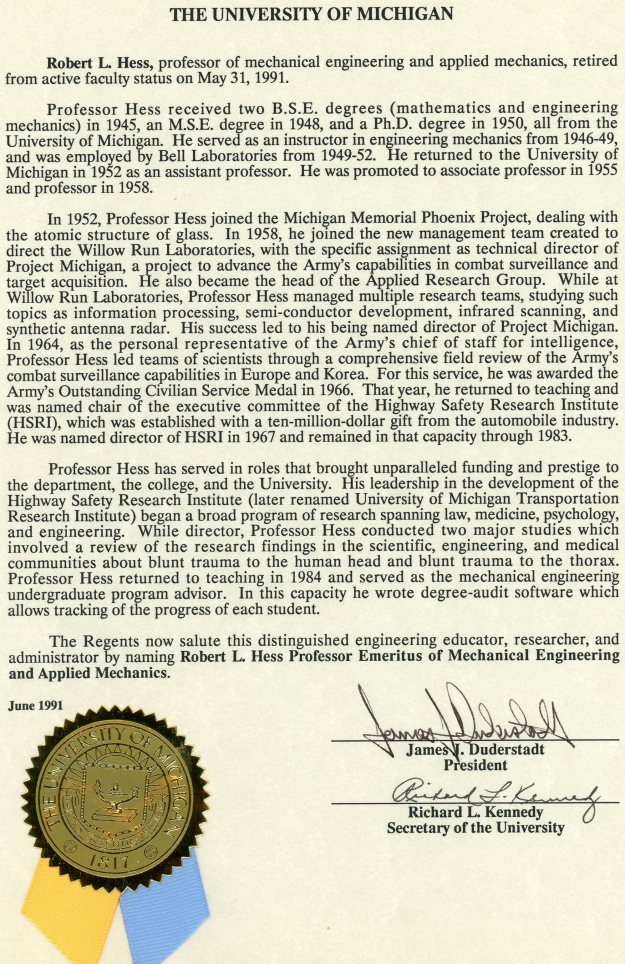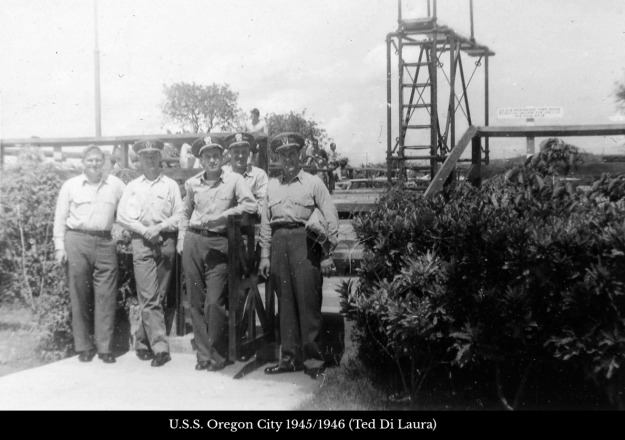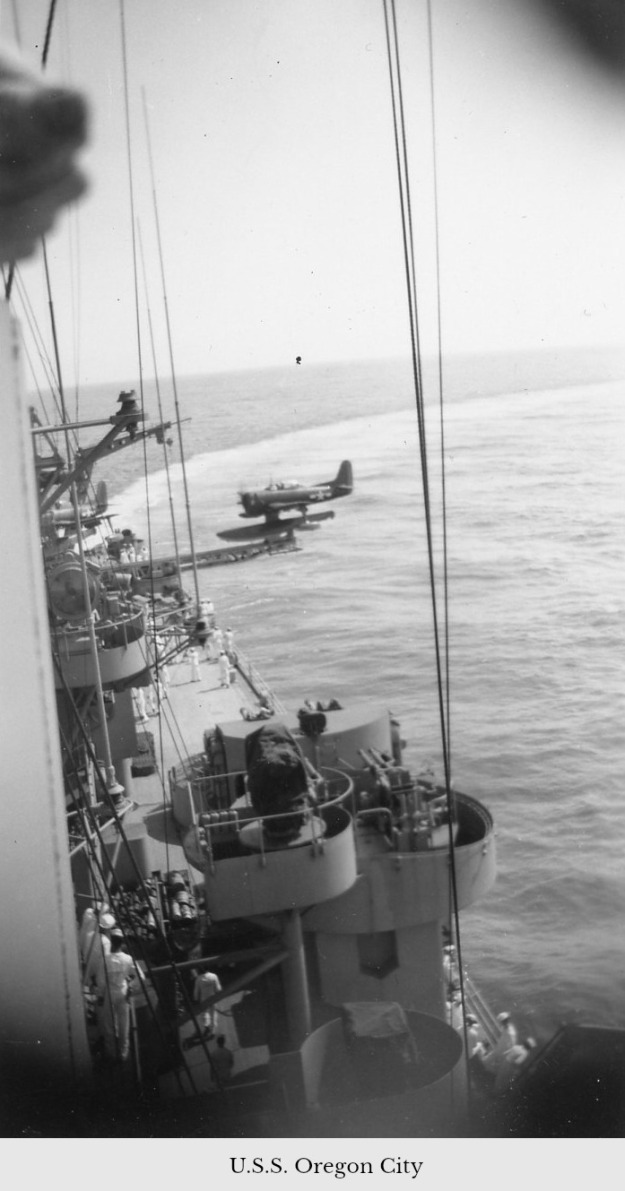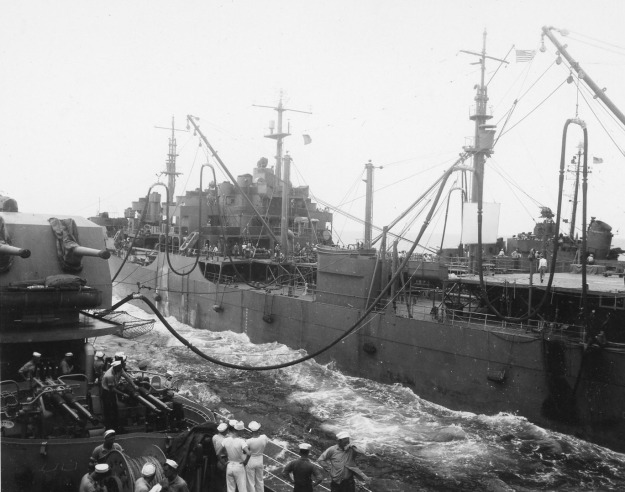 Memorandum to File: Nov. 24, 1986
Memorandum to File: Nov. 24, 1986
Subject: Robert L. Hess’s History of Research, Service and Teaching Contributions to the University of Michigan.
In 1945, Professor Hess received two B.S.E. degrees from the University of Michigan in less than a 3 year period, one in Engineering Mathematics and the other in Engineering Mechanics after which he served as an Engineering Officer in the U.S. Navy. Hess served as junior Division officer, main engines division, on a heavy cruiser at sea and later as auxiliary Division officer on a pair of light escort carriers.
Upon release from active World War II service he returned to Ann Arbor, the home of his wife, Gretchen R. (REAM) Hess. On a visit to the Engineering Mechanics office he was hired as a full-time Instructor and was asked to undertake a research project by Prof. J. Ormandroyd. The project became the basis of his Doctorial Thesis, “The Dynamics of Ship’s Structures, including Shear Deformations”. This work was directed by Professor Ormandroyd and became one of the first major engineering works to be programmed for the ENIAC (that being done by the David Taylor Model Basin, Dept. of the Navy). During the three years of full time teaching as an Instructor, (Dr.) Hess served in the U.S. Naval Ready Reserve and spent his training periods at the Model Basin. He was honored by being requested to provide 40 hours of lectures at the Model Basin on advanced mathematics and dynamics for the scientific staff of the U.S. Navy when he was 24 years old.
Professor Hess was recruited by the Bell Telephone Laboratories and joined BTL, upon completion of his doctorate, as a Member of the Technical Staff in the fall of 1949, being assigned to a ‘heavy-tube’ Development Group. The many research projects he participated in included the assignment to undertake the development of a pilot line for the production of both the material for and the devices known as ‘point-contact’, type A transistors.(This was before the courts ordered BTL to place the technology on the market and was thus a unique endeavor for Dr. Hess upon which several of the newly licensed companies partly based their developments.) It was typical of him to have the breadth of both interest and scientific knowledge that brought him such a coveted assignment and also success in it. He developed new techniques of crystal growing and zone-purifying as well as a novel method of doping the contact area using microwave techniques to created photo-sensitive transistors.
In his third year at BTL Dean G.G. Brown called him with an unsolicited invitation to return to the U. of M. as an Assistant Prof. of Chemical and Metallurgical Eng. and Assistant Professor of Engineering Mechanics and to also take on a Phoenix Project dealing with the atomic structure of glass. Dean Brown gave Prof. Hess the challenge of creating a new course in structure of glass and ceramics. At the end of his third year Hess was promoted to Associate Professor of Engineering Mechanics and left the Chem. Met. Dept. He undertook the reactivation of the Engineering Mechanics Department’s Photo-Elasticity Lab. and generated a course for it as well as teaching in the areas of elasticity and dynamics.
In about 1957, Vice President and Dean of Faculties, Prof. M. Niehus asked Prof. Hess to join an elite committee of engineers and scientists to oversee the work of the Willow Run Laboratories which at that time was experiencing troubled relationships with the Department of the Army, its prime source of support. In Jan. 1958 Dean Niehuss requested that Hess take leave of his teaching and consulting practice and join a new management team, headed by Prof. J.A. Boyd (now Chairman of Harris Corp.) to salvage and redirect the Willow Run Laboratories. Hess was given the specific assignment of Technical Director of Project Michigan, a 4 to $6 million/year program, as well as an Assistant Directorship of WRL. In addition Hess became the Head of the Applied Research Group of the Labs, which at that time had just demonstrated the MASER and a year prior to the demonstration of the Ruby LASER. Hess was instrumental in extending optical data processing to the field of automatic photo-interpretation. In March of 1958 Dean Attwood informed Hess of the approval of his promotion to full Professorship. ( A promotion which was said to make Hess the youngest full professor in the College’s history up to that time.)
Prof. Hess soon developed a keen ability to manage multiple teams of researchers on topics varying from Information processing, semiconductor development, infrared scanning and synthetic antenna radar. He was able to apply his knowledge of basic physics and mathematics to the tasks as a member of the research teams and also represented them to general officers representing the U. S. Army, and, upon the creation of a Department of Defense to the scientific part of that community. In his unique fashion and with unusual modesty, his term of management, which after three years included the project directorship as well as its technical direction, Hess always put his staff in the foreground and sacrificed personal fame in the process. Never-the-less upon his decision to return to teaching, the Department of the Army awarded Prof. Hess with THE OUTSTANDING CIVILIAN SERVICE AWARD and METAL the inscription of which read in part ‘Hess succeeded in establishing and maintaining the University of Michigan as the leading free world authority in surveillance technology. His own proven scientific talent and professional imagination contributed additionally to the accomplishments of a broad team of scientists and technicians. The rare combination of skill, foresight and devotion to country….’.
During the years of 1964 and 1965, Hess served as the personal representative of the U.S. Army’s Assist. Chief of Staff for Intelligence and led teams of scientists though a comprehensive field review of the Army’s Combat Surveillance capabilities both in Europe and in Korea. The Army implemented over 70% of his technical recommendations for the Korean area. In 1965 Professor Hess visited with President H. Hatcher with the view of leaving the Project Michigan assignment and returning to full-time teaching. By that time, the I.S.T. had been created and W.R.L. was part of it and Hess was one of its Directors. President Hatcher, through Prof. Norman, Vice President for Research offered Hess the challenge of using the $10 million original gift from the automobile industry to create the Highway Safety Research Institute. This was a special honor as that gift was reported to have been the largest gift in the University’s history at that time. Upon acceptance, Hess hired a top level ‘internal administrator’ for H.S.R.I. and thus was able to devote his attention to building the staff and its research programs and also to return to teaching which was his first love. With a Regent ally appointed Executive Committee and with the cooperation of dozens of the University’s faculty Hess was able in a few years to build a facility, hire internationally known figures and to build a program of research spanning fields from Law to Medicine and from Engineering to Psychology. His untiring drive established the Institute as the world’ premier institution of its kind and brought not only many millions of research dollars to our campus for the support of researchers, faculty, and graduate students but also enhanced the reputation of the University of Michigan.
During his tenure at H.S.R.I., Hess served as a consultant to the Army’ Science Board where he both chaired and participated in the study of many of the nation’s outstanding technical problems and challenges.
Professor Hess personally undertook two major research studies while teaching a nearly full load and directing the H.S.R.I. These were the review of the complete research findings in the scientific, engineering and medical communities of the experimentation protocols and the same for the area of blunt trauma to the human head and the same for the area of blunt trauma the thorax. In each case an annotated history of the development of the use of the knowledge in regulation was developed and recommendations were made for future research in the fields. The second of these studies was selected for publication in the S.A.E.’ transactions. Hess served the University by membership on President Nixon’s Highway Safety Advisory Committee and also undertook several overseas services as a Consultant to the Wor1d Hea1th Organization.
Prof Hess resigned his position as Director of U.M.T.R.I. (the successor to H.S.R.I.) and returned to a full time faculty teaching role in January of 1984. Shortly thereafter Hess founded a computer software company, HCCI, which deals in engineering specialty software for a international audience in the forensic engineering area. In keeping with his reputation, he has undertaken the teaching of the Control Systems course, ME461, a new course for him, with vigor and has provided new leadership in its laboratory and course work with several software packages he has written to enhance the depth and breath of the educational experience of the students. These include programs dealing with Fourier techniques, general integration methods, data plotting, frequency analysis, root locus, Nyquist techniques, Myk1lestad and Holzer techniques, matrix iteration techniques, eigenvalue/eigenvector techniques and many others. He also accepted an assignment as the Mechanical Engineering Program Advisor and has written degree-audit software packages now used by the Mechanical Engineering and Applied Mechanics department. The implementation of modern techniques allows Professor Hess, as the Advisor, to take a proactive rather than a reactive role in counseling. Similar HCCI software is now being installed in a large engineering college.
Professor Hess’s academic and service accomplishments are outstanding and the respect that he has gained from his peers is only reflective of the credit he has given to them over a total of 37 years of devoted service to the University. In the Pentagon, corporate offices, the classroom and laboratory he has represented the best the University of Michigan could offer its students and country.






































 Memorandum to File: Nov. 24, 1986
Memorandum to File: Nov. 24, 1986